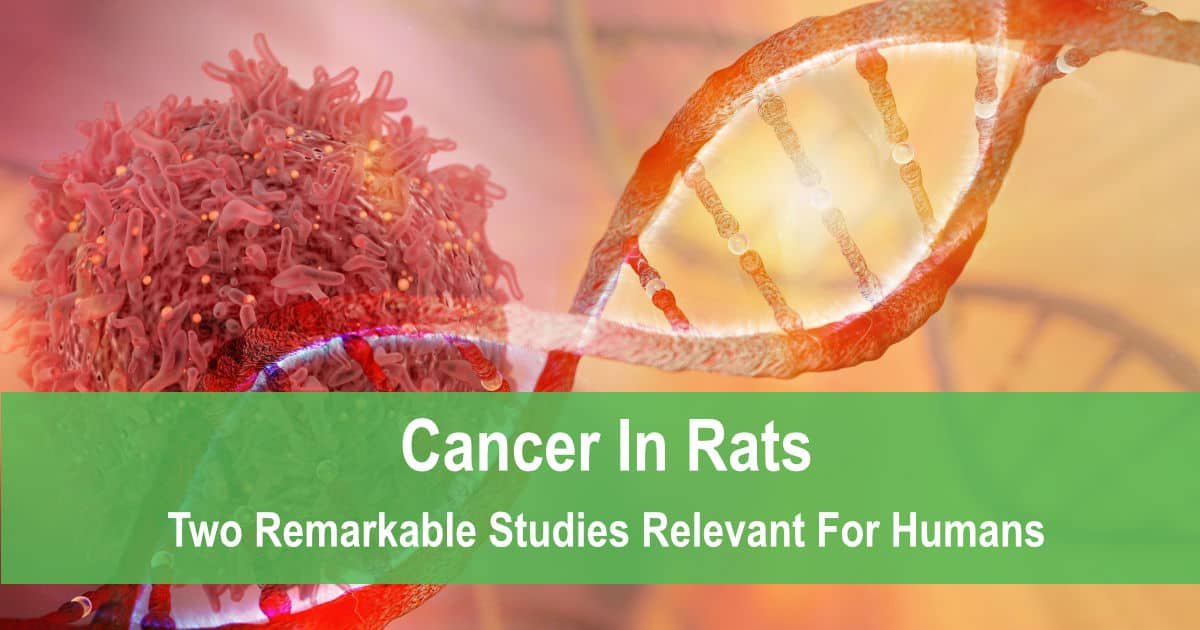Cancer In Rats: Two Remarkable Studies Relevant For Humans

The two studies we’re about to discuss, show that cancer in rats is determined mainly by the amount and the type of protein consumed. Both studies show that nutrition plays a key role in cancer in rats, especially plant versus animal foods.
The first study was performed in India.
The Experimental Cancer in Rats Study in India
In the India study, two groups of rats were given different levels of dairy protein (casein). One group was going to consume 20% protein (high protein group), the other group 5% protein (low protein group). Both groups were also given the carcinogen aflatoxin.
So what happened to the two groups?
Of the 30 rats that were part of the high protein group, half developed tumors, and the other half had precancerous lesions.
Of the 12 rats that were part of the low protein group, one developed a kidney tumor, and the rest did not develop tumors or precancerous lesions.
This was a remarkable outcome and a reliable indicator that the development of cancer in rats is determined mainly by nutrition. The research suggested that nutrition has more power than carcinogens like aflatoxin.
Upon reading about the India cancer in rat’s studies and its conclusions, Dr Campbell set out to repeat and do more variations of the same research. More remarkable insights would follow.
Turning Cancer in Rats On and Off
Dr Campbell decided to run the same experiment as done in India. Two groups of rats were given aflatoxin. One group was fed a 5% casein protein diet, the other a 20% casein protein diet. The results were the same as the India study!
The next variable was to give different amounts of the aflatoxin carcinogen. The low protein group (5%) got a high dose of aflatoxin, while the high protein group (20%) got a low dose of aflatoxin. Could the rats who consumed the most cancerous seeds alter their course by eating a low protein diet?
The answer: Yes!
The study showed that the high aflatoxin, low protein group had fewer foci than the low aflatoxin, high protein group. Foci are tiny clusters of cancer-like cells, an early indicator of tumor formation.
Then the researchers went one step further. Again, two groups of rats started with a 5% and 20% protein and given the same amount of aflatoxin. Both groups would alternate their level of protein intake during a 12-week period.
As expected, the 20% protein group had more foci. After 6 weeks, the high protein group switched to a low protein (5%) diet. Between weeks 7 and 9, the foci development decreased a lot! During weeks 10 to 12, the group switched back to the high protein diet, which resulted in a sharp increase in foci development.
Like flipping a light switch on and off, we could control cancer promotion merely by changing the levels of protein, regardless of initial carcinogen exposure.
— Dr Campbell (The China Study, page 60)
The research then went a little further than solely focusing on the early indicators of tumor development (foci). In this next part of the study, actual tumor formation would be measured. Several hundred rats were part of the study. The study was 100 weeks in length. Rats generally live 2 years, so the study would roughly span the lifetime of a rat.
All animals were given the same level of aflatoxin. All the rats who were fed the 20% casein protein diet developed liver tumors and were dead before the 100-week mark. None of the rats who were fed the 5% casein protein diet had liver tumors and were alive and well at the 100-week mark.
In another similar study, rats were again alternated between different levels of protein intake. The levels of protein intake were switched at either the forty or sixty-week mark. The ones who were switched from the high protein to the low protein diet had 35-40% less tumor growth than those that were only eating a high protein diet.
All these variations and variables confirmed that the initial India study was not a fluke. Indeed, regardless of carcinogen exposure, cancer in rats could be turned “on” and “off” simply by switching the level of protein intake.
What About Protein From Plant Foods?
Instead of giving dairy protein, what would happen if rats were given plant protein? The same experiment was performed. Aflatoxin was administered to two groups of rats. One group was fed a 5% plant protein diet, the other a 20% plant protein diet. The plant protein consisted of soy and gluten (the protein in wheat).
In the experiments, both the 5% and 20% plant protein groups did not promote cancer cell growth.
More studies were then done on rats and other animals, with different types of cancer and various nutrients, including fish protein. The results would remain in line with Dr Campbell’s cancer in rats studies:
Furthermore, a pattern was beginning to emerge: nutrients from animal-based foods increased tumor development while nutrients from plant-based foods decreased tumor development.
— Dr Campbell (The China Study, page 66)
Why Would These Studies be Relevant for Humans Too?
Even though these studies were done on rats, they may still be relevant for humans because the human body has a similar protein need than the protein need of rats.
Also, protein metabolism works roughly the same in rats and humans. Another reason for human relevance is that the levels of protein given to the rats are similar to the levels humans generally consume.
Dr Campbell would soon have an opportunity to participate in a large-scale human study, which gave many more insights about the relation between diet and disease. It is called The China Study.
This article is an excerpt from page 27-67 of The China Study by Dr. Campbell.
